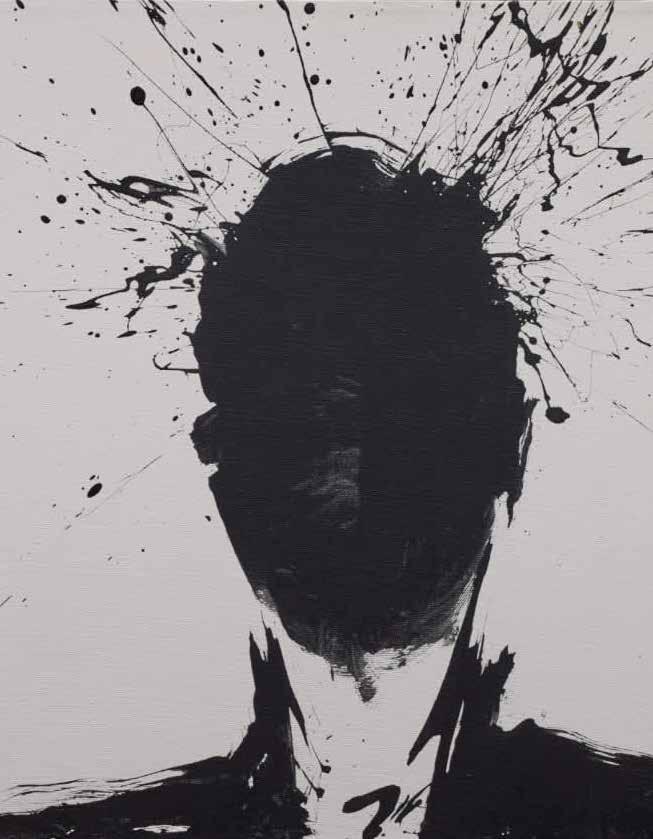
4 minute read
Why are Collectors Fighting to Buy Richard Hambleton Art?
BY JAMES NICHOLLS
Richard Hambleton is often referred to as the “Godfather of street art,” although this is a title that the artist rejected. Best known under the guise of Shadowman, he painted series of sinister-looking silhouettes on the streets of New York, before eventually turning to canvas and paper. Working alongside Haring and Basquiat, Hambleton dominated the downtown New York art world during the 1970s and ’80s.
Despite being a household name in New York’s street art scene, and much loved by galleries and critics alike, Richard Hambleton is today undoubtedly the least known and appreciated artist when compared to Haring and Basquiat. However, this could all be set to change.
Maddox Gallery was honoured to recently co-host a retrospective exhibition of Hambleton’s work in Leake
Street Arches, and an exclusive screening of upcoming biopic Shadowman, directed by Oren Jacoby and nominated for Best Documentary at the Tribeca Film Festival in 2017. Attendees were incredibly receptive to Hambleton’s art, and we’re confident that interest will only grow further in the future,
“I consider his works as ‘figurative Jackson Pollock,’” New York gallerist Hong Gyu Shin recently told Artnet. “I believe he is one of the most important American figurative painters and street artists. I’m confident that his market will keep appreciating.
“People often compare Richard and Basquiat. Richard is Richard, though I think his market will become as big Basquiat’s, as big as Pollock’s, and as big as de Kooning.”
Reasons for Richard Hambleton’s rising popularity
All but one of Hambleton’s top 10 auction sales have occurred within the last year, and it’s thought that this huge market development has been triggered by two factors.
Firstly, Richard Hambleton art is the focus of award-winning documentary Shadowman, which premiered at the Tribeca Film Festival in April 2017. The film tracks the artist’s life from 80s New York street art scene to global renown.
Second, Hambleton sadly passed away in October 2017 at the age of 65. The prolific artist had produced conceptual artworks throughout his long career, but now there was suddenly a finite number of works.

Within months, the artist’s paintings at auction went from fetching a couple of thousand dollars to tens of thousands. l ‘Jumping Shadow Man’ (1984) was sold by Artnet for $108,000 l Opening (1983) beat its €7,000 low estimate by over 20 times at Blindarte in Milan, reaching the incredible figure of €150,000 l Fountain of Youth II (1984) was estimated at $20,000$30,000, but sold at Sotheby’s for $150,000 l An untitled triptych (1986) went for $216,000 at artnet’s Urban Art sale, well over the $100,000 to $150,000 estimate
As the world burns (1983) sold for $552,000 at Artcurial’s auction in Paris, soaring above the work’s $140,000 estimate and Hambleton’s $215,000 auction record
Private sellers report even bigger numbers, with one collector noting to Artnet that they’ve sold his works for numbers between $500,000 and $1 million Ghada Dergham, one of Hambleton’s largest collectors, explains:
“What’s happening is the collection of people that have been part of Richard’s world — be it collectors or dealers or someone who just bought a piece from him — they’re all seeing the renewed interest in his work.”

Richard Hambleton art is an unknown volume
Just like Basquiat and Haring, Hambleton’s life and production of art was arguably cut short. However, it’s impossible to calculate how many works Hambleton made, or how many are in circulation today.
“For years and years, we’ve been selling Richard’s work,” says Kristine Woodward, co-owner of Woodward Gallery in New York. “But Richard was also selling and trading his own work.”
“There was an imbalance,”
Woodward says. “Our gallery and some other dealers were selling his work privately for tens of thousands of dollars; Richard was selling from the studio for thousands or even hundreds of dollars — whatever he could get.”
This may have been due in part to the artist’s long and well-documented battle with heroin addiction, which often hindered his career, led to a period of homelessness and ultimately contributed to his early death.
However, Hambleton was also known for his anti-establishment beliefs, and while he did work with a number of galleries, it was rarely in an official capacity. Despite a blossoming demand for Richard Hambleton art, the artist started to retreat from this world by the early ’90s, objecting to the corporate values.
What’s more, Hambleton was diagnosed with skin cancer, scoliosis and kyphosis — all of which were aggravated by his continued battle with addiction, causing him to be in poor health for much of his later life.
It’s still possible to buy Richard Hambleton art
Despite all of these obstacles, Richard Hambleton has endured in the contemporary art canon as the grandfather of New York street art, and an established name across the world. Here at Maddox Gallery, we are delighted to be able to show some of his works at our upcoming exhibition. Please pay a visit to one of our central London galleries to find out more about the incredible opportunity to invest in Richard Hambleton art.
To find out more about any of our represented artists, please contact Maddox Gallery. Our Sotheby’s-trained art consultants will be happy to provide expert advice. PS

Reprinted with permission from medium.com











